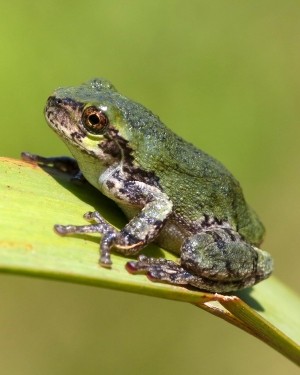
Photo by Mary Holland
.If there is an amphibian that is a master of disguise, it has to be the gray treefrog (Hyla versicolor). The adults of this species are capable of changing color (gray, green, or brown) to match their environment, a process called metachrosis. Shades of gray with black blotches on the back are most common and allow these frogs to blend in with tree bark – so well, in fact, that they can be hard to find, unless you follow the males’ bird-like trills. During warm, humid nights from April through July, these frogs call from trees and shrubs bordering wetlands. Juvenile gray treefrogs, such as the one pictured here, start off bright emerald green and may measure a mere ½ inch. Adults are generally around 2 inches long. When a gray treefrog is young and newly metamorphosed, it usually remains near the forest floor. As it ages, it may transition to living in the forest canopy, using its rounded toe pads to cling to and climb vertical structures.

